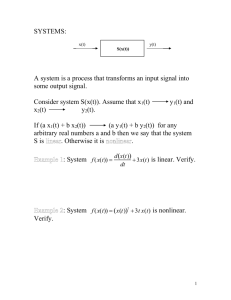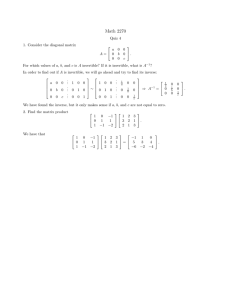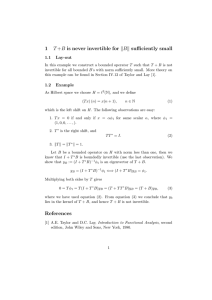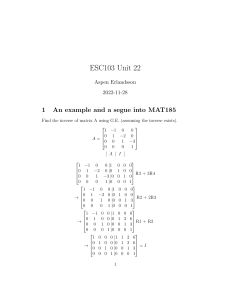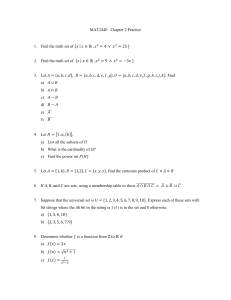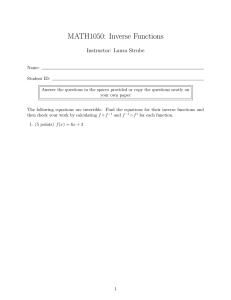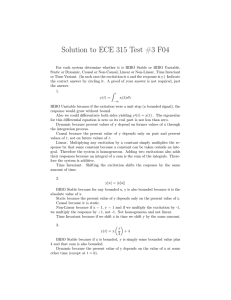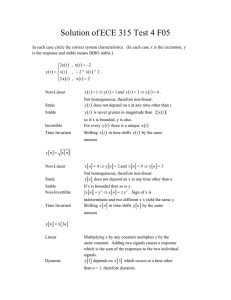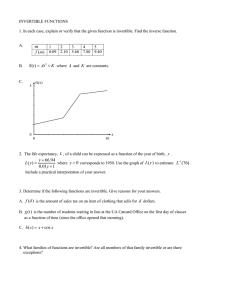Signal Processing: System Properties - Invertibility, Causality
advertisement
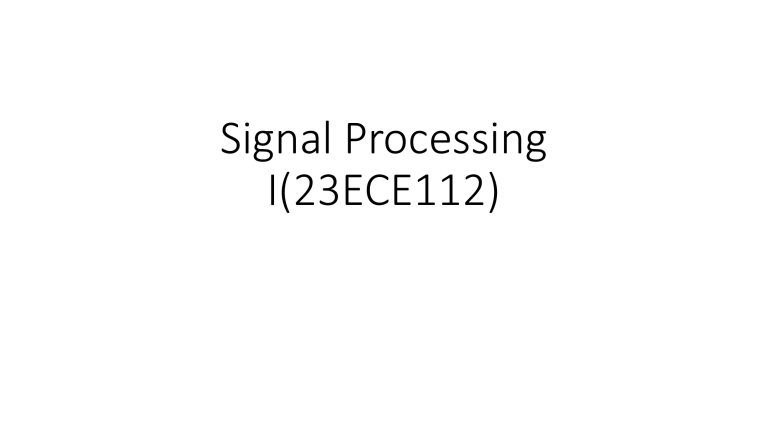
Signal Processing I(23ECE112) Invertible and Non-invertible systems • A system is said to be invertible if distinct input signal produces a distinct output signal. • For an invertible system, every unique input maps to a unique output. • Hence, if we are given the output of this system, we can find the input signal that caused this output provided we know the behaviour of the system. In other words, we can find the inverse of the output. • If this is not possible, the system is said to be non-invertible Systems Invertible Non-invertible Examples of invertible and non invertible systems • Invertible systems: 𝑦 𝑡 = 5𝑥 𝑡 , 𝑦 𝑡 = 𝑥 𝑡 − 𝑡0 , 𝑦 𝑡 = 𝑥 3𝑡 • 𝑦[𝑛] = 𝑥[𝑛 − 𝑛0 ], 𝑦 𝑛 = σ𝑛𝑘=−∞ 𝑥[𝑘] • Non-invertible systems: 𝑦(𝑡) = 𝑥 2 (𝑡) , 𝑦 𝑡 = 0, 𝑦 𝑡 = |𝑥(𝑡)| • 𝑦[𝑛] = 𝑥[2𝑛],𝑦[𝑛] = |𝑥[𝑛]| Practice Problems • Check whether these systems are invertible or non-invertible 𝑦(𝑡) = sin(𝑥 𝑡 ) 𝑦 𝑡 =𝑥 𝑡 +2 𝑦 𝑡 =ቊ 𝑥 𝑡 5 𝑖𝑓 𝑥(𝑡) ≤ 5 𝑜𝑡ℎ𝑒𝑟𝑤𝑖𝑠𝑒 𝑦 𝑡 = 𝑥 3𝑡 + 2 𝑦[𝑛] = 𝑥[2𝑛 − 3] 𝑦[𝑛] = cos(𝑥[𝑛]) 𝑦[𝑛] = 𝑚𝑥[𝑛] + 𝑐 𝑦 𝑛 = 0.25𝑥[𝑛] Practice Problems • Check whether these systems are invertible or non-invertible 𝑦(𝑡) = sin(𝑥 𝑡 )-ni 𝑦 𝑡 =𝑥 𝑡 +2 𝑥 𝑡 𝑦 𝑡 =ቊ 5 𝑦 𝑡 = 𝑥 3𝑡 + 2 -i 𝑦[𝑛] = 𝑥[2𝑛 − 3]-ni 𝑦[𝑛] = cos(𝑥[𝑛])-ni 𝑦[𝑛] = 𝑚𝑥[𝑛] + 𝑐-i 𝑦 𝑛 = 0.25𝑥[𝑛]-i 𝑖𝑓 𝑥(𝑡) ≤ 5 𝑜𝑡ℎ𝑒𝑟𝑤𝑖𝑠𝑒 Inverse of system • If a system is invertible, we can find an inverse system that performs the reverse action of the system. 1 • 𝑦 𝑡 = 5𝑥 𝑡 has inverse system 𝑦 𝑡 = 5 𝑥 𝑡 • 𝑦 𝑡 = 𝑥 𝑡 − 𝑡0 has inverse system as 𝑦 𝑡 = 𝑥 𝑡 + 𝑡0 • If we connect a system in cascade with its own inverse system, we get back the input signal x(t) Inverse of a system • We can obtain the inverse of a system for discrete time systems also. • We call a system as identity system if the output is the same as the input. 𝑦 𝑡 = 𝑥(𝑡) or 𝑦[𝑛] = 𝑥[𝑛] • The cascade connection of an invertible system with its inverse produces an identity system. Practice Problem • Check the inverse systems for those systems which are invertible 𝑦(𝑡) = sin(𝑥 𝑡 ) 𝑦 𝑡 =𝑥 𝑡 +2 𝑦 𝑡 =ቊ 𝑥 𝑡 5 𝑖𝑓 𝑥(𝑡) ≤ 5 𝑜𝑡ℎ𝑒𝑟𝑤𝑖𝑠𝑒 𝑦 𝑡 = 𝑥 3𝑡 + 2 𝑦[𝑛] = 𝑥[2𝑛 − 3] 𝑦[𝑛] = cos(𝑥[𝑛]) 𝑦[𝑛] = 𝑚𝑥[𝑛] + 𝑐 𝑦 𝑛 = 0.25𝑥[𝑛] Practice Problem • Check the inverse systems for those systems which are invertible 𝑦(𝑡) = sin(𝑥 𝑡 ) - ni 𝑦 𝑡 =𝑥 𝑡 +2 x(t)=Y(t)-2 𝑦 𝑡 =൜ 𝑦 𝑡 = 𝑥 3𝑡 + 2 x(t)=y(t/3 -2/3) 𝑦[𝑛] = 𝑥[2𝑛 − 3] -ni 𝑦[𝑛] = cos(𝑥[𝑛]) -NI 𝑦[𝑛] = 𝑚𝑥[𝑛] + 𝑐 –x(n)=[y(n)-c]/m 𝑦 𝑛 = 0.25𝑥[𝑛] x(n)=1/0.25 y(n) 𝑥 𝑡 5 𝑖𝑓 𝑥(𝑡) ≤ 5 𝑁𝐼 𝑜𝑡ℎ𝑒𝑟𝑤𝑖𝑠𝑒 Causality • A system is called a causal system if its output value at the present time instance depend only on the input values at present and previous time instances, not at future time instances. • Causal systems are also called as non-anticipative systems. • Example: 𝑦(𝑡) = (t − 1)𝑥 𝑡 , 𝑦 𝑛 = 4𝑥[𝑛], 𝑦 𝑡 = 𝑥(𝑡 − 3), 𝑦 𝑛 = 𝑥[𝑛 − 4], 𝑦 𝑡 = log(𝑥(𝑡)), 𝑦 𝑛 = 𝑒 𝑥[𝑛] • If the output of a system depends on future time instances of input, then we say that the system is noncausal. • Example: 𝑦(𝑡) = 𝑥 3𝑡 , 𝑦 𝑛 = 𝑥[2𝑛], 𝑦 𝑡 = 𝑥(𝑡 + 5), 𝑦 𝑛 = 𝑥[𝑛 + 5] Practice Problem • Check if the following systems are causal or not 𝑦(𝑡) = 𝑥 0.25𝑡 𝑦 𝑡 = 𝑥 2𝑡 + 3 𝑦 𝑡 =x t +5 𝑦 𝑛 = 𝑥 𝑛 + 𝑥[𝑛 + 2] 𝑦[𝑛] = 𝑥[5𝑛] 𝑦[𝑛] = 𝑥 2 [𝑛] Practice Problem • Check if the following systems are causal or not 𝑦(𝑡) = 𝑥 0.25𝑡 -no 𝑦 𝑡 = 𝑥 2𝑡 + 3 -no 𝑦 𝑡 = x t + 5 -causal 𝑦 𝑛 = 𝑥 𝑛 + 𝑥[𝑛 + 2]- no 𝑦[𝑛] = 𝑥[5𝑛] - no 𝑦[𝑛] = 𝑥 2 [𝑛] - causal Some observations • If a system is memoryless, then it is definitely a causal system. • Note that the converse is not true. i.e if a system is given as causal then it need not be memoryless. • Non-causal systems cannot be realized in practice if the future values of input to the system are not known. • Are the systems 𝑦 𝑡 = 𝑥 −𝑡 and 𝑦 𝑡 = 𝑥 𝑡 + sin(𝑡 + 2) causal? Time invariance • A system is time invariant if system characteristics does not change over time. • If a time invariant system produces an output y(t) for an input x(t) applied today, it will produce the same output y(t) when the same input signal x(t) is applied tomorrow or some other time. • This circuit is time invariant system if the value of the resistors do not change with respect to time. • If the resistor values change over time, then the given system is a time variant system Time invariance • Let the input to a continuous time system be x(t) and the corresponding output be given as y(t). • If the system is time invariant, then a shifted input 𝑥 𝑡 − 𝑡0 will produce 𝑦 𝑡 − 𝑡0 . i.e the output is the same signal but shifted by the same amount as the input signal. • Similarly, If the input to a discrete time system is x[n] with a corresponding output y[n], then for time invariant system a shifted input 𝑥 𝑛 − 𝑛0 will produce an output 𝑦 𝑛 − 𝑛0 Examples of time invariant systems • Check if the system 𝑦 𝑡 = log(𝑥(𝑡)) is time invariant or not? • 𝑦 𝑡 = log(𝑥(𝑡)), Now apply a new signal 𝑥1 𝑡 = 𝑥 𝑡 − 𝑡0 . Then corresponding output 𝑦1 𝑡 is given by • 𝑦1 𝑡 = log 𝑥1 𝑡 = log(𝑥 𝑡 − 𝑡0 ) • If 𝑦1 𝑡 = 𝑦(𝑡 − 𝑡0 ) then the system is time invariant. • 𝑦 𝑡 − 𝑡0 = log 𝑥 𝑡 − 𝑡0 = 𝑦1 𝑡 . Therefore, the system is time invariant. Practice problem • Check if the system 𝑦 𝑛 = 𝑛 𝑥[𝑛] is time invariant or not? • 𝑦 𝑛 = 𝑛 𝑥[𝑛], Now apply a new signal 𝑥1 [𝑛] = 𝑥 𝑛 − 𝑛0 . Then corresponding output 𝑦1 [𝑛] is given by • 𝑦1 𝑛 = 𝑛 𝑥1 𝑛 = 𝑛 𝑥 𝑛 − 𝑛0 • If 𝑦1 [𝑛] = 𝑦 𝑛 − 𝑛0 then the system is time invariant. • 𝑦 𝑛 − 𝑛0 = 𝑛 − 𝑛0 𝑥 𝑛 − 𝑛0 = 𝑛 𝑥 𝑛 − 𝑛0 - 𝑛0 𝑥 𝑛 − 𝑛0 ≠ 𝑦1 𝑛 . Therefore the system is time variant. Practice problem • Check if the system 𝑦 𝑡 = 𝑥(2𝑡) is time invariant or not? • 𝑦 𝑡 = 𝑥(2𝑡), Now apply a new signal 𝑥1 𝑡 = 𝑥 𝑡 − 𝑡0 . Then corresponding output 𝑦1 𝑡 is given by • 𝑦1 𝑡 = 𝑥1 2𝑡 = 𝑥(2𝑡 − 𝑡0 ) • If 𝑦1 𝑡 = 𝑦(𝑡 − 𝑡0 ) then the system is time invariant. • 𝑦 𝑡 − 𝑡0 = 𝑥 2 𝑡 − 𝑡0 = 𝑥(2𝑡 − 2𝑡0 ) ≠ 𝑦1 𝑡 . Therefore, the system is time variant Systems Time invariant Time variant Practice problem • Check if the following systems are time invariant or not 𝑦 𝑡 = 2𝑡 𝑥 𝑡 𝑡 𝑦 𝑡 =𝑥 2 𝑦 𝑡 = 3x t − 3 𝑦 𝑛 = 2𝑥 𝑛 𝑦[𝑛] = 𝑥[2𝑛 − 3] 𝑦[𝑛] = 𝑒 𝑛 𝑥[𝑛] Practice problem • Check if the following systems are time invariant or not 𝑦 𝑡 = 2𝑡 𝑥 𝑡 - no 𝑦 𝑡 =𝑥 𝑡 2 -no 𝑦 𝑡 = 3x t − 3 -yes 𝑦 𝑛 = 2𝑥 𝑛 -yes 𝑦[𝑛] = 𝑥[2𝑛 − 3]-no 𝑦[𝑛] = 𝑒 𝑛 𝑥[𝑛]-no Homogeneity Property • Let the input to a continuous time system be x(t) and the output signal be y(t). • If the system is homogenous, then a new input 𝑥1 𝑡 = 𝑎 𝑥 𝑡 will produce a new output given by 𝑦1 𝑡 = 𝑎 𝑦 𝑡 where a is a constant. • In other words, if your input is scaled by a constant value then the output is also scaled by the same constant. • Example: 𝑦 𝑡 = 5𝑥 𝑡 • If we apply a new input 𝑥1 𝑡 = 𝑎 𝑥 𝑡 then the output will be 𝑦1 𝑡 = 5 𝑎 𝑥 𝑡 Therefore the system is homogenous =𝑎 5𝑥 𝑡 = 𝑎 𝑦(𝑡). Examples of homogenous systems • 𝑦[𝑛] = 𝑥[𝑛 − 𝑛0 ] • If we apply a new input 𝑥1 [𝑛] = 𝑎 𝑥[𝑛] then the output will be 𝑦1 [𝑛] = 𝑥1 [𝑛 − 𝑛0 ] = 𝑎 𝑥 𝑛 − 𝑛0 = 𝑎 𝑦[𝑛]. Therefore, the system is homogenous • 𝑦(𝑡) = 𝑙𝑜𝑔(𝑥 𝑡 ) • If we apply a new input 𝑥1 𝑡 = 𝑎 𝑥 𝑡 then the output will be 𝑦1 𝑡 = 𝑙𝑜𝑔 𝑎 𝑥 𝑡 = 𝑙𝑜𝑔 𝑎 + log(𝑥 𝑡 ) ≠ 𝑎 𝑦(𝑡). Therefore, the system is not homogenous • 𝑦 𝑛 =𝑥 𝑛 +5 • If we apply a new input 𝑥1 [𝑛] = 𝑎 𝑥[𝑛] then the output will be 𝑦1 [𝑛] = 𝑥1 𝑛 + 5 = 𝑎 𝑥 𝑛 𝑎 𝑦 𝑛 = 𝑎 𝑥 𝑛 + 5 = 𝑎 𝑥 𝑛 + 5𝑎 ≠ 𝑦1 [𝑛]. Therefore, the system is not homogenous + 5. Additivity/Superposition • Let 𝑥1 (𝑡) and 𝑥2 (𝑡) be two different inputs to a system and let 𝑦1 (𝑡) and 𝑦2 𝑡 be their corresponding outputs. • A system is said to have additivity property if an input 𝑥1 𝑡 + 𝑥2 (𝑡) produces an output 𝑦1 𝑡 + 𝑦2 𝑡 . • In other words, if a system possesses additive property, the output(response) of the system corresponding to a sum of two inputs will be the sum of the individual outputs generated by these inputs. • Note that if the above is true for two inputs, then it can be generalised to n inputs • If the outputs corresponding to the inputs 𝑥1 (𝑡) , 𝑥2 𝑡 , …, 𝑥𝑛 (𝑡) are 𝑦1 (𝑡), 𝑦2 𝑡 , … 𝑦𝑛 𝑡 then the input 𝑥1 𝑡 + 𝑥2 𝑡 + ⋯ + 𝑥𝑛 𝑡 produces an output 𝑦1 𝑡 + 𝑦2 𝑡 + ⋯ + 𝑦𝑛 𝑡 . Additivity/Superposition • Similarly, we can define additive property for discrete time systems also. Let 𝑥1 [𝑛] and 𝑥2 [𝑛] be two different inputs to a system and let 𝑦1 [𝑛] and 𝑦2 [𝑛] be their corresponding outputs. • A system is said to have additivity property if an input 𝑥1 [𝑛] + 𝑥2 [𝑛] produces an output 𝑦1 [𝑛] + 𝑦2 [𝑛]. • If the outputs corresponding to the inputs 𝑥1 [𝑛] , 𝑥2 [𝑛], …, 𝑥𝑘 [𝑛] are 𝑦1 [𝑛], 𝑦2 [𝑛], … 𝑦𝑘 [𝑛] then the input 𝑥1 [𝑛] + 𝑥2 [𝑛] + ⋯ + 𝑥𝑘 [𝑛] produces an output 𝑦1 [𝑛]+ 𝑦2 𝑛 + ⋯ + 𝑦𝑘 [𝑛]. Example • 𝑦 𝑡 = 3𝑥 𝑡 − 2 • Let 𝑥1 (𝑡) and 𝑥2 (𝑡) be two different inputs to this system then their corresponding outputs are given by. • 𝑦1 𝑡 = 3𝑥1 (𝑡 − 2), 𝑦2 𝑡 = 3𝑥2 (𝑡 − 2) • Now we apply an input 𝑝 𝑡 = 𝑥1 𝑡 + 𝑥2 (𝑡). Let the output be q(t). • 𝑞 𝑡 = 3𝑝 𝑡 − 2 = 3 𝑥1 𝑡 − 2 + 𝑥2 𝑡 − 2 • Hence the system has additivity property = 3𝑥1 𝑡 − 2 + 3𝑥2 𝑡 − 2 = 𝑦1 𝑡 + 𝑦2 𝑡 Example • 𝑦 𝑡 = 𝑥2 𝑡 • Let 𝑥1 (𝑡) and 𝑥2 (𝑡) be two different inputs to this system then their corresponding outputs are given by. • 𝑦1 𝑡 = 𝑥1 2 (𝑡), 𝑦2 𝑡 = 𝑥2 2 (𝑡) • Now we apply an input 𝑝 𝑡 = 𝑥1 𝑡 + 𝑥2 (𝑡). Let the output be q(t). • 𝑞 𝑡 = 𝑝2 𝑡 = 𝑥1 𝑡 + 𝑥2 𝑡 2 = 𝑥1 2 𝑡 + 𝑥2 2 𝑡 + 2𝑥1 (𝑡) 𝑥2 (𝑡) ≠ 𝑦1 𝑡 + 𝑦2 𝑡 • Hence the system does not have additivity property Example • 𝑦 𝑛 =𝑥 𝑛 +2 • Let 𝑥1 [𝑛] and 𝑥2 [𝑛] be two different inputs to this system then their corresponding outputs are given by. • 𝑦1 𝑛 = 𝑥1 𝑛 + 2, 𝑦2 𝑛 = 𝑥2 𝑛 + 2 • Now we apply an input 𝑝[𝑛] = 𝑥1 [𝑛] + 𝑥2 𝑛 . Let the output be q[n]. • 𝑞 𝑛 = 𝑝 𝑛 + 2 = 𝑥1 𝑛 + 𝑥2 𝑛 + 2 ≠ 𝑦1 [𝑛] + 𝑦2 [𝑛] • Hence the system does not have additivity property Practice Problems • Check if the following systems are additive or not 𝑦 𝑡 = 𝑥 𝑡+3 𝑦 𝑡 = log(𝑥(𝑡)) 𝑦 𝑡 = 𝑥(2𝑡) 𝑦 𝑛 = sin(𝑥 𝑛 ) 𝑦[𝑛] = 𝑥[2𝑛 + 3] 𝑦[𝑛] = 𝑒 𝑥[𝑛] Practice Problems • Check if the following systems are additive or not 𝑦 𝑡 = 𝑥 𝑡 + 3 -yes 𝑦 𝑡 = log(𝑥(𝑡))-no 𝑦 𝑡 = 𝑥(2𝑡)-yes 𝑦 𝑛 = sin(𝑥 𝑛 )-no 𝑦[𝑛] = 𝑥[2𝑛 + 3]-yes 𝑦[𝑛] = 𝑒 𝑥[𝑛] -no Stability of a system • A stable system is one in which small inputs do not lead to outputs/responses that diverge to infinity. • If the response of a system grows unbounded when the input is small and bounded, then the system is said to be unstable. • A Bounded Input Bounded Output (BIBO) stable system is one in which the output is always bounded to be less than a limit when the input is guaranteed to be less than a limit. • Mathematically if |𝑥(𝑡)| ≤ 𝐵𝑖 , then |𝑦(𝑡)| ≤ 𝐵𝑜 for all time instances for a Bounded Input Bounded Output (BIBO) stable system where 𝐵𝑖 and 𝐵𝑜 are constants. • If the above is not true for a system, we say that the system is BIBO unstable. • Similarly for discrete time systems if |𝑥[𝑛]| ≤ 𝐵𝑖 , produces an output |𝑦[𝑛]| ≤ 𝐵𝑜 for all time instances n, then it is a Bounded Input Bounded Output (BIBO) stable system. Example • 𝑦 𝑛 = σ𝑛𝑘=−∞ 𝑥 𝑘 • Assume that the input signal is bounded |𝑥[𝑛]| ≤ 𝐵𝑖 • |𝑦 𝑛 | = | σ𝑛𝑘=−∞ 𝑥 𝑘 | ≤ σ𝑛𝑘=−∞ 𝑥 𝑘 ≤ σ𝑛𝑘=−∞ 𝐵𝑖 = ∞ • |𝑦 𝑛 | becomes ∞ if we assume 𝑥 𝑛 = 𝐵𝑖 for all n. There fore the system is not BIBO stable. Example • 𝑦 𝑛 = 0.5 𝑥 𝑛 + 2 𝑥 𝑛 − 3 • Assume that the input signal is bounded 𝑥 𝑛 ≤ 𝐵𝑖 • 𝑦 𝑛 = 0.5 𝑥 𝑛 + 2 𝑥 𝑛 − 3 ≤ 0.5 𝑥 𝑛 + 2 𝑥 𝑛 − 3 ≤ 0.5𝐵𝑖 + 2𝐵𝑖 = 2.5𝐵𝑖 = 𝐵𝑜 • |𝑦 𝑛 | becomes 2.5𝐵𝑖 if we assume 𝑥 𝑛 = 𝐵𝑖 for all n. There fore the system is BIBO stable. Example • 𝑦(𝑡) = 𝑒 𝑥(𝑡) • Assume that the input signal is bounded 𝑥(𝑡) ≤ 𝐵𝑖 • 𝑦(𝑡) = 𝑒 𝑥(𝑡) = 𝑒 𝑥(𝑡) ≤ 𝑒 𝐵𝑖 = 𝐵𝑜 • |𝑦(𝑡)| becomes 𝑒 𝐵𝑖 if we assume 𝑥(𝑡) = 𝐵𝑖 . There fore the system is BIBO stable. Example • 𝑦(𝑡) = 𝑡𝑥(𝑡) • Assume that the input signal is bounded 𝑥(𝑡) ≤ 𝐵𝑖 • 𝑦(𝑡) = 𝑡𝑥(𝑡) = 𝑡 |𝑥(𝑡)| ≤ |𝑡|𝐵𝑖 • Output does not reach ∞ as long as t is finite. But if t->∞ the output also diverges to ∞. • Hence the system is not BIBO stable. Practice Problems • Check if the following systems are BIBO stable or not 𝑦 𝑡 = 𝑥 2𝑡 + 5 𝑡 𝑦 𝑡 = න 𝑥 𝜏 𝑑𝜏 −∞ 𝑡2 𝑦 𝑡 = 𝑥(𝑡 + 2) 2 𝑦 𝑛 =3𝑥 𝑛 𝑦 𝑛 = 𝑛 𝑥[𝑛 − 4] 𝑦 𝑛 = 𝑥 𝑛 − 𝑥[𝑛 − 1] Practice Problems • Check if the following systems are BIBO stable or not 𝑦 𝑡 = 𝑥 2𝑡 + 5 -yes 𝑡 𝑦 𝑡 = −∞ 𝑥 𝜏 𝑑𝜏-no 𝑦 𝑡 = 𝑡2 2 𝑥(𝑡 + 2)-no 𝑦 𝑛 = 3 𝑥 𝑛 -yes 𝑦 𝑛 = 𝑛 𝑥[𝑛 − 4]-no 𝑦 𝑛 = 𝑥 𝑛 − 𝑥[𝑛 − 1]--yes
